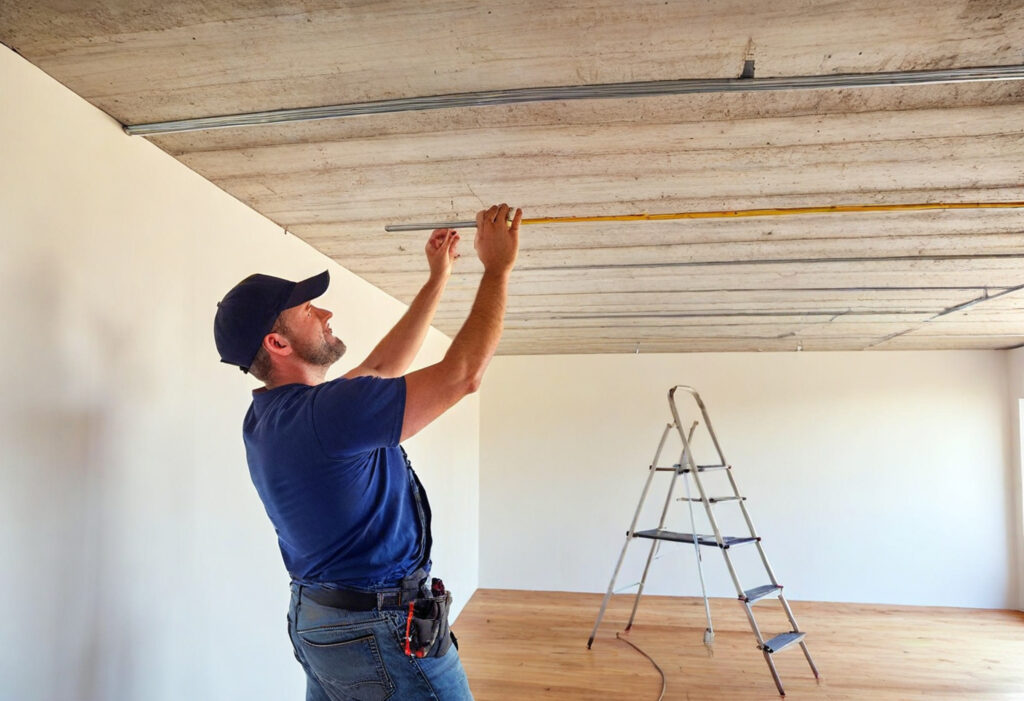Are you curious about drop ceiling installation costs for your home? You can expect to pay between $4 to $20 per square foot installed. These prices can affect your renovation budget by a lot.
Your drop ceiling project needs careful planning for both materials and labor costs. A typical 100 to 200-square-foot ceiling installation costs between $400 and $4,000. Labor costs run about $1.50 to $5.00 per square foot. The materials, such as tiles and grid systems, add another $2 to $3 per square foot. Basement installations cost anywhere from $2,000 to $40,000 based on your space and material choices.
This piece takes a closer look at the factors that shape these prices, from material quality to room size. You’ll learn practical ways to cut costs while maintaining quality. We’ll help you decide whether to handle this as a DIY project or bring in professionals. Let’s explore all the essential details about drop ceiling costs and installation.
Understanding Drop Ceiling Installation Costs
The cost of drop ceilings can swing widely based on several key factors. Let’s break down the costs you need to think about before starting your project.
Average drop ceiling cost per square foot
A drop ceiling installation costs between $4 to $20 per square foot when installed. Most people pay $9 to $13 per square foot for standard installations with average-quality materials. These prices cover both materials and labor.
The labor costs run $1.50 to $5.00 per square foot, which works out to $50 to $150 per hour for professional installation. The final price depends on your choice of ceiling tiles and their quality.
Total cost range based on room size
The size of your room directly affects how much you’ll spend:
| Room Size (sq. ft.) | Average Cost Range |
|---|---|
| 50 | $200 – $1,000 |
| 100 | $400 – $2,000 |
| 150 | $600 – $3,000 |
| 200 | $800 – $4,000 |
| 250 | $1,000 – $5,000 |
| 500 | $2,000 – $10,000 |
| 1,000 | $4,000 – $20,000 |
Across the country, homeowners typically spend between $1,076 and $3,320 on their drop ceiling projects. The national average sits at about $2,191.
What affects the price the most?
Your choice of materials makes a big difference in the final cost. You can pick from basic mineral fiberboard ($1 to $4 per square foot) or go for high-end wood tiles ($10 to $70 per square foot).
Room complexity plays a huge role in labor costs. You’ll pay more if installers need to work around furnaces, water heaters, pipes, and ductwork. A room full of obstacles needs extra planning and installation time.
Your ceiling might need extra support structures, which can drive up costs. Local building permits (starting at $150) and inspections might be required too.
Big projects often need more than just ceiling installers. You might need electricians ($40-$100/hour), plumbers ($45-$150/hour), and HVAC experts ($75-$150/hour) to move fixtures, pipes, or ductwork.
Breaking Down the Material Costs
Your drop ceiling budget depends heavily on material selection. A clear understanding of component costs will help you make smart decisions about spending and saving.
Drop ceiling tile cost per square foot
Ceiling tile prices vary significantly from $1.00 to $70.00 per square foot. The quality and style you choose determine the final cost. Simple mineral fiberboard tiles cost just $1.00 to $4.00 per square foot. These tiles are perfect for budget-conscious projects. PVC ceiling tiles represent excellent value at $1.00 to $2.00 per square foot. They deliver good durability and moisture resistance at a lower price point than alternatives.
Grid system pricing explained
A sturdy framework supports your new ceiling and costs between $1.50 and $2.25 per square foot for materials. T-bars create the structure that holds your ceiling tiles in place and attach to your walls. The grid’s finishes come in white, black, and tan to match your chosen tile color.
Cost of insulation panels and light tiles
Insulation panels behind ceiling tiles boost energy efficiency and noise reduction at $1.50 to $2.50 per square foot. These panels improve thermal performance and reduce sound transfer between floors. Light panel integration costs range from $20.00 to $50.00 per panel, including materials and installation. Specialty insulating fiberglass ceiling panels with high R-values cost more, ranging from $168.00 to $176.00 for quality 3-inch thick panels.
Material cost variations by tile type
The material choice affects your overall budget significantly:
- Fiberboard/Mineral Fiber: $1.00 to $7.00 per square foot, with simple sound absorption
- Plastic/PVC: $2.00 to $9.00 per square foot, with moisture resistance
- Black Acoustic: $1.00 to $6.00 per square foot, perfect for entertainment spaces
- Metal: $3.00 to $13.00 per square foot, with durability and water resistance
- Wood: $2.00 to $70.00 per square foot, adding warmth and sophistication
Size variations play a role in pricing. The 1×1 tiles cost $1.08 to $4.99 per square foot. Prices for 2×2 tiles range from $2.66 to $5.59, while 2×4 tiles cost between $3.09 and $14.54 per square foot.
Labor and Additional Installation Costs

Your drop ceiling project’s total cost includes professional installation, which takes up about 20-25% of the budget. A clear understanding of these extra costs helps you plan your finances better.
Labor cost to install drop ceiling
Professional contractors charge $1.50 to $5.00 per square foot for drop ceiling installation. Their hourly rates typically range between $50.00 and $150.00. The costs rise significantly if installers need to work around furnaces, water heaters, or plumbing systems.
The room’s layout plays a crucial role in determining final costs. Larger projects often cost less per square foot because contractors can buy materials in bulk. However, rooms with multiple fixtures or structural challenges need more planning time, which drives up the overall expense.
Cost of removing old ceiling
Most installations require removing the existing ceiling first. Contractors charge $1.00 to $7.00 per square foot to remove a drop ceiling. Complete ceiling demolition costs between $1.55 and $3.06 per square foot.
The removal process might reveal other issues that need attention:
- Interior demolition: $4.00 to $10.00 per square foot
- Mold remediation: $15.00 to $30.00 per square foot
- Asbestos removal: $4.00 to $20.00 per square foot (certified professionals required)
Permit and inspection fees
Local authorities often require building permits for ceiling installations to check proper clearance heights. Small projects like drop ceilings usually need permits starting at $150.00. Your contractor typically handles permit applications and inspection scheduling as part of their service.
Hiring specialists: electrician, HVAC, plumber
Complex installations may need these additional professionals:
- Electricians: $40.00 to $100.00 per hour (plus a possible $75.00 call-out fee)
- HVAC technicians: $75.00 to $150.00 per hour for ductwork changes
- Plumbers: $45.00 to $150.00 per hour for pipe relocation
- General contractors: $50.00 to $150.00 per hour for project oversight
Homeowners report paying between $100.00 to $800.00 for construction debris removal after project completion.
Smart Ways to Save on Your Drop Ceiling

You can cut your drop ceiling installation costs without sacrificing quality. Smart planning and the right choices can help you save hundreds or even thousands on your project.
Use standard tile sizes and materials
Standard-sized ceiling tiles (2×2 or 2×4) cost less than custom dimensions. Most homes look better with 2×2 tiles that create an even look and fit well in smaller rooms. Business spaces usually go for 2×4 tiles because they’re cheaper and work better with lighting fixtures. Mineral fiber ceiling tiles give you great sound control at lower costs and cut noise by over 50%. Plastic tiles ($5-$9 per square foot) offer good value because they resist moisture and are easy to install.
Buy in bulk or by the pallet
Buying ceiling tiles by the case saves you money—cases cost $40-$160 and cover 20-128 square feet. Larger projects benefit from pallet purchases. Each pallet holds 160-320 tiles and gives you a better value per square foot. Buying directly from suppliers helps you avoid contractor markups on materials.
Choose lay-in systems for easier install
Lay-in ceilings are the most affordable drop ceiling option. They use a visible metal grid where tiles simply rest in place instead of being permanently attached. This design lets you replace damaged or stained tiles without taking down the whole system.
DIY vs hiring a contractor: what saves more?
Installing the ceiling yourself could save you about $1,200 (around $3.50 per square foot). Drop ceiling installation tricks many people—the grid leveling process is tough. Most homeowners end up finding that professional installation prevents expensive mistakes and looks more polished.
Avoiding unnecessary add-ons
Simple suspended ceiling designs with standard T-bar grids are accessible to more people and affordable. Light aluminum frameworks reduce costs and installation time. Keeping new wiring runs minimal and leaving ceiling vents where they are can save you big on specialist contractor fees. Taking down your old ceiling before the professionals arrive is another good way to cut labor costs.
Conclusion
Drop ceiling installation is a big investment for homeowners. Costs range from $4 to $20 per square foot based on your choices. Material selection drives most budget decisions. Mineral fiberboard tiles are budget-friendly, while premium wood options add elegance at a higher cost.
Your room’s size and layout will affect the final price. A standard 200-square-foot room costs between $800 and $4,000. Complex spaces with obstacles need extra labor hours and expert skills. Planning ahead for issues like old ceiling removal or utility rerouting helps avoid unexpected costs.
You can save money through smart choices. Using standard tile sizes, buying in bulk, and picking simple grid systems cuts expenses without losing quality. While DIY installation might save labor costs, the technical challenges make hiring professionals a better choice. They ensure proper leveling and maintain structural integrity.
This project works great for basement finishing or home office updates. Understanding these costs helps you make smart decisions about your ceiling project. You now know to plan your installation, manage your budget, and create the space you want. Your new ceiling will improve acoustics, hide utilities, and look great – making it worth the investment.
